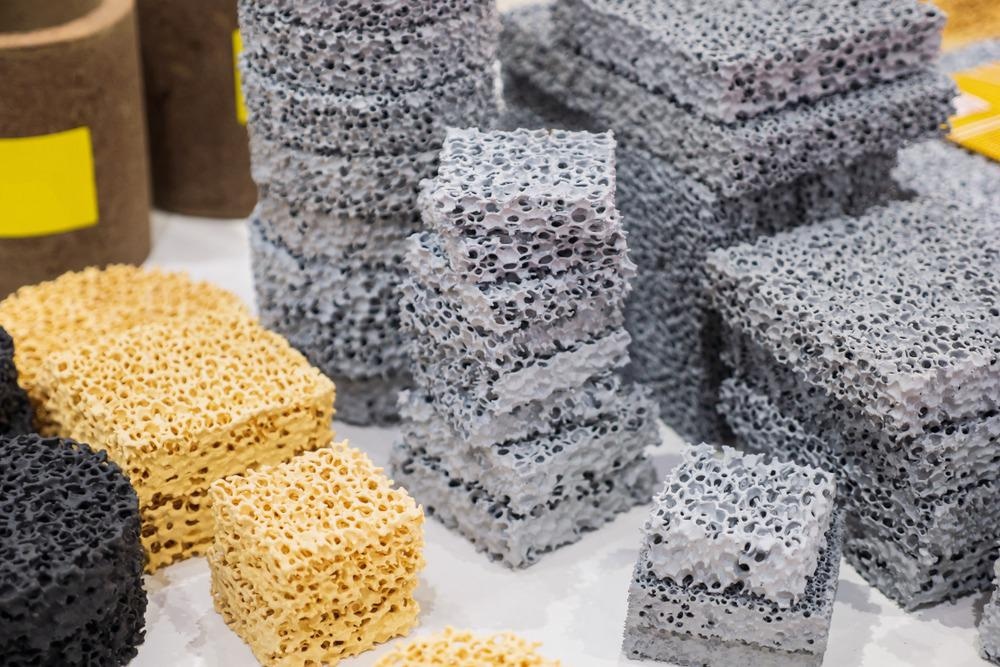In a study recently published in the Journal of the European Ceramic Society, a unique method of using nanoparticle-stabilized ceramic foams with boehmite in conjunction with silica as a dual-phase sol to produce mullite ceramic foams has been presented.

Study: Mullite ceramic foams with tunable pores from dual-phase sol nanoparticle-stabilized foams. Image Credit: socrates471/Shutterstock.com
Nanoparticles (NPs) help increase the specific surface area of ceramic foams. The mullite ceramic foams produced have hierarchical pores, better compression strength, and a high level of open porosity.
An Introduction to Mullite Ceramics
Mullite (3Al2O3.2SiO2), as a stable compound, has been used frequently as a refractor and a structural material for high-temperature applications owing to its superior properties such as high melting point, low creep rate, minimal heat conduction, and strong resistance to thermal shocks.
Due to its small dielectric constant, Mullite is also a good electronic circuit substrate. On the other hand, its conventional compact structure hinders the development of certain characteristics and limits its potential applications.
Adding a high porosity to mullite ceramics might give them unexpected properties, including small volume density, high specific area, decreased heat conduction, and reduced dielectric constant. Aerogels made from mullite nanofibersare better suited for lightweight insulating substances.
Owing to the open porous structure of mullite, ceramic foams have been extensively used as high-temperature gas and fluid screens, separation films, and catalyst supporters.
Porous mullite ceramics have been manufactured using various techniques, such as reactive sintering, freeze-casting, foams or emulsions template, adding pore former method replica, gel-casting, and 3D printing.
Unfortunately, barely any products manufactured using these processes yield more than 80% porosity. It is crucial to develop a successful process for fabricating high porosity mullite ceramic foams without sacrificing compressive strength, but it remains difficult.
Using Nanoparticles to Enhance Ceramic Foams
Lately, nanoparticle-stabilized foams have been produced using sol-NPs. In contrast with traditionally employed micro-scale ceramic particles, sol-NPs are much more beneficial for foam stability, the creation of pored ceramics with layer-thin walls and small grain sizes, yielding greater compressive strength based on high porosity.
Moreover, the specific area of ceramic foams is also increased, which might be related to improved frittage reactivity and partial frittage.
As a result of partial frittage, the use of NPs would form open pores on the cell membrane. The interconnectivity of open pores will increase the available surface area and porosity, making it suited for use as filters, catalytic supports, and biological scaffolding. These characteristics may be regulated by adjusting the concentrations of surface modifiers, which would modify the electrostatic interaction energy between air bubbles and colloidal particles and, as a result, alter the characteristics of the foams.
Thus far, single-phase sol has already been used effectively to generate nanoparticle-stabilized foams, including alumina and silica. However, the properties of the porous mullite ceramic foams produced do not satisfy the expectations of highly porous structure, homogeneity, and reduced pore diameter.
Dual-phase sol-NPs as building blocks for nanoparticle-stabilized foams might be promising for addressing this issue, resulting in an optimum porosity microstructure combined with mechanical qualities following reaction frittage.
Still, because of the disparity between particle surface states, obtaining stable foams through dual-phase sol is more complex than single-phase sol.
Details of the Study
The research suggests a simple, straightforward, and inexpensive method for producing mullite ceramic foams using foams supported by dual-phase sol NPs.
The sol NPs were modified to make their surface hydrophobic. By varying the frittage temperature and solid loading, the researchers created mullite ceramic foams with hierarchical pores, increased porosity, significant compression strength, and reduced heat conduction.
Using sol NPs with constant surface charge and pH levels is preferable to guarantee homogenous blending of dual-phase sol without aggregation. As a result, the starting ingredients were boehmite sol with an initial pH level of 6.2 and silica sol having a comparable pH of 4.3.
The pH was increased to a range of 5.0-6.0, which improved foam stability and promoted the creation of gel networks, resulting in optimal rheological properties.
To Conclude
For the first time, boehmite sol and silica sol were used as the dual-phase sol to construct nanoparticle-stabilized foams, and mullite ceramic foams with hierarchical porosity were created.
To increase foam stability, pH was changed in the foaming procedure to promote the gelling of dual-phase sol NP-stabilized foam.
Mullite ceramics were found to have increased compression strength while having low heat conduction, making them suitable for use as filters, catalytic supports, and thermal insulation.
Continue reading: Why is Understanding the Rheology of Nanofluids Important?
Reference
Yang J, Z. X. (2021) Mullite ceramic foams with tunable pores from dual-phase sol nanoparticle-stabilized foams. Journal of the European Ceramic Society. Available at:https://www.sciencedirect.com/science/article/pii/S095522192100902X?via%3Dihub
Disclaimer: The views expressed here are those of the author expressed in their private capacity and do not necessarily represent the views of AZoM.com Limited T/A AZoNetwork the owner and operator of this website. This disclaimer forms part of the Terms and conditions of use of this website.